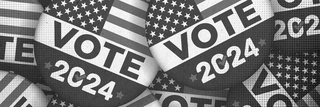
To Prevent Chaos and Confusion, Judges Must Prepare for Election Emergencies
In advance of the election, judges should educate themselves on election administration and develop emergency response procedures that will enable creation of effective remedies.
Judges are increasingly being called into the election process and asked to make consequential decisions that impact voters’ rights and the security of elections under immense time pressures and scrutiny. It is more important than ever that the judges charged with resolving these disputes understand basic information about election administration, including the checks, backup plans, and layered processes that election officials deploy to keep elections secure and accurate.
A judicial election in Pennsylvania last fall provides a cautionary tale.
The voters there used touchscreen voting machines to make their selections, as many counties across the country do, and then cast printed paper ballots with a record of their votes. On this day, however, numerous voters told poll workers that the printed ballots did not match their selections, and they feared that their vote would not be counted correctly as a result. In examinations done later, officials determined that a clerical error during programming had caused the issue. But on Election Day, the most pressing issue was not who to blame, but how to guarantee that voters could cast an accurate ballot.
The county and local political parties turned to the court to help resolve the matter, launching a sequence of events that only added to the confusion. Over the course of the day, three judges issued three different orders.
The first order instructed poll workers to continue using the faulty voting equipment and to use specific language to explain the issue to voters, but the language was so confusing that poll workers reported long lines as voters paused to ask for clarity.
The second order directed poll workers to offer paper ballots that could be marked by hand to voters who were impacted by the programming error, though some voters who were entitled to use these paper ballots likely never noticed that their selections were not printed correctly.
The third order provided a new set of instructions that misidentified the judicial races implicated by the programming error, threatening poll workers with contempt if they failed to make statements some must have known to be false.
Our new article in the Penn Statim, “How to Head Off an Election Emergency,” provides a primer for judges on what they need to know to make informed decisions quickly. We cover three aspects of the election process.
First, we lay out common contingency plans that election officials use to make sure voters can continue casting ballots through equipment malfunctions, voter check-in errors, scanner failures, and resource shortages. Judges should be aware of these options — and how to best use them — when ordering relief in these scenarios. Second, we explain the multiple records that election officials deploy to track ballots and make certain that ballots are cast only by eligible voters. Finally, we outline the steps that election officials follow to count ballots and confirm vote totals before certifying complete, final, and accurate results. Judges may be able to take advantage of these steps and the associated records to craft and tailor appropriate remedies.
We also recommend neutral, nonpartisan steps that courts can take ahead of elections to prepare for emergencies that may arise.
Courts can create clear rules for assignment and consolidation of emergency motions filed on or immediately after Election Day. Where possible, the same judge should consider related issues to provide continuity and minimize the risk of conflicting orders.
Next, to avoid adding further confusion to chaos, judges — and attorneys bringing lawsuits — should consult with election administrators when crafting any language that election workers must follow or convey as part of an order. This input will help confirm that terminology is used correctly and processes are described accurately.
Finally, judges and attorneys should develop an understanding of available contingency plans, systems, and data sources that election officials have in place to prevent and recover from disruptions during the election process. This understanding will go a long way to ensuring smooth, orderly, and timely implementation of remedies that could otherwise lead to further disruption and delay.
It takes hundreds of thousands of poll workers — spread across over 100,000 polling locations, managing sometimes outdated technology, and operating under intense pressure — to pull off a presidential election. Errors and mistakes are inevitable. But in the current political environment, even minor mishaps will receive significant scrutiny and be used to fuel distrust of the election process.
It is vital for democracy that all officials making decisions that impact the voting process — judges especially — understand how to ensure accurate counts, safeguard voting rights, and protect and support free and fair elections.
Derek Tisler is a counsel in the Brennan Center for Justice’s Elections & Government program.
Gowri Ramachandran is the Director of Elections and Security in the Brennan Center for Justice’s Elections & Government program.
Suggested Citation: Derek Tisler & Gowri Ramachandran, To Prevent Chaos and Confusion, Judges Must Prepare for Election Emergencies, Sᴛᴀᴛᴇ Cᴏᴜʀᴛ Rᴇᴘᴏʀᴛ (Oct. 1, 2024), https://statecourtreport.org/our-work/analysis-opinion/prevent-chaos-and-confusion-judges-must-prepare-election-emergencies.



Related Commentary
Pennsylvania Supreme Court Says Provisional Ballots Cast by Voters Whose Mail-Ballots Were Invalid Must Be Counted
The ruling denies the Republican National Committee’s appeal arguing that Pennsylvanians should not have a second chance to vote if their mail-in ballots are disqualified because they made a mistake
What’s at Stake in the 2024 Ohio Supreme Court Elections
The outcome of the races for three seats on the high court could impact Ohio law on abortion, voting rights, gun regulations, and more.
What Litigation After the 2020 Election Can Tell Us About 2024
Efforts to disqualify mail-in ballots and unfounded allegations of voter fraud dominated post-election litigation in 2020. Similar efforts are possible this month.
2024 Ballot Measures to Watch
Voters will decide whether to amend their state constitutions with measures focusing on abortion, election procedures, minimum wage policy, and more.